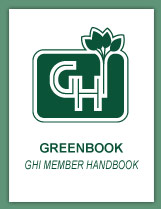I. Greenbelt Homes, Inc. (GHI) - A Housing Cooperative
GREENBELT HOMES, INC. (GHI) - A HOUSING COOPERATIVE
- Legal Basis of GHI
- A Membership Cooperative
Greenbelt Homes, Inc. is a not-for-profit corporation, which enables individual families, through cooperative endeavor, to fulfill their housing needs in comfortable, pleasant surroundings at relatively low costs.
Cooperative housing is a form of home ownership in which the interest of each purchaser is represented by a Mutual Ownership Contract which creates a membership and share of the ownership in the Corporation, and which gives the member the right to perpetual use of a particular dwelling unit.
Prospective purchasers of GHI homes submit an application for membership at the time they select a particular dwelling unit. Their application must be approved by the Board of Directors in order to become a member.
Like all privileges, membership entails certain responsibilities; these responsibilities are prescribed by the Mutual Ownership Contract (MOC) and the Bylaws. Two underlying principles govern the use of Corporate controls: equal treatment for all members and decision making based upon the best interest of the majority of members.
The fundamental authority of GHI is vested in the members, who (through one vote per household) elect the Board of Directors and act on certain Corporation matters as established in the Bylaws. The Board of Directors establishes policies and guides the administration of the Corporation through the Management staff, which is responsible for implementing the policies and for the actual operations. Thus the avenues of control begin with the membership and extend through the Board to Management. - The GHI Charter
Greenbelt Homes, Inc. is incorporated under the laws of the State of Maryland (1949) as a perpetual not-for-profit Corporation without capital stock. It is a membership Corporation. The charter sets forth the purpose of the Corporation and provides the legal framework for its operation. - The Bylaws of the Corporation
The Bylaws established the purpose and powers of the Corporation, its principles of operation, its means of handling business, its method of electing directors to supervise and control the business operations, and its financial controls. The Bylaws insure effective control by the membership by giving each member an equal share (one vote). A copy of the Bylaws is included in this handbook.
The Board of Directors sets policies and engages the General Manager to operate the business to best serve the members. A successful operation depends upon effective teamwork between the members, the Board of Directors, and Management.The Bylaws provide for democratic procedures. From a practical standpoint, direct authority over business affairs is given to the Board of Directors, as is the case in any business that is too unwieldy for direct operation by its members or stockholders. Voting on issues may occur at either Annual or Special Meetings or may be conducted through mail referendums. A quorum necessary to transact business at membership meetings has been set at five (5) percent of the membership, or 75 members, whichever is less. Each member is urged to participate in all membership meetings and elections. Any member may be elected to the Board of Directors, Audit Committee, or Nominations and Elections Committee or appointed to serve on advisory committees. Each member has a stake in the Corporation, which the member can protect by exercising the right to vote in membership meetings and elections.
- The Mutual Ownership Contract - The Basic Member Document
The Mutual Ownership Contract is the contractual agreement between the member and the Corporation, which establishes the rights and obligations of both. This contract is the legal framework within which each member occupies and enjoys a particular residence for which title is legally held by Greenbelt Homes, Inc. It sets forth the services members can expect from GHI and the policies, which the member must observe while occupying a GHI home. All members should carefully read their Mutual Ownership Contract to understand its terms and the responsibilities of all parties.Membership may be terminated for cause or for default of financial obligations due the Corporation under processes set forth in the Bylaws, which can include the right of appeal to the membership at a membership meeting.
- A Membership Cooperative
- Data on GHI Properties
The following information describes GHI, including its subsidiary corporation.- Amount of Land Owned 250 acres
- Break-down of Housing Units
Brick & Block (constructed in 1937)
Honeymoon Cottage (1 br) 16
1 1/2 bedroom 45
2 Bedroom 154
2 Bedroom & Studio 44
2 1/2 bedroom 168
3 Bedroom 152
Total brick and block homes 579Frame (constructed in 1941)
1 bedroom 140
2 bedroom 602
3 bedroom 250
Total frame homes 992Larger Homes (constructed in 1967-70)
4 bedroom 29TOTAL HOMES 1,600
- Garages
One hundred attached, closed garages were sold with specific residences and constitute an inseparable part of their dwelling unit. The Corporation owns 275 garages, which are available for rental by members.
- Greenbelt Development Corporation Apartments and Garages
Greenbelt Development Corporation is a subsidiary corporation owned by GHI. The Board of Directors of GHI votes the stock of the subsidiary Corporation and elects its directors, usually the same directors as those of GHI.
GDC owns 60 apartments on Parkway Road together with 52 garages. GHI administers the GDC properties, selling necessary services and thus spreading administrative expenses over more residential units. When there is an annual operating surplus, it benefits GHI.
- Gardenside-Serviceside - A Greenbelt Planning Feature
A unique feature of Greenbelt's original planning reversed the conventional arrangement as to the front and rear sides of homes. In GHI homes, the front entrance faces the interior of the block on what is called the gardenside. The back door, leading into the rear hallway, kitchen and utility room, faces either a court or the street, on what is called the serviceside of the building. Clothes posts, storage for trash, and mail delivery are usually on the serviceside.
Parks and the interior network of walkways serve the gardenside of the homes. In many cases the gardenside faces an undeveloped wooded area owned by GHI as part of the common area.
These latter areas require full member cooperation to retain their sylvan beauty and are not to be used as dumping grounds.The serviceside, which is really the working and business side, provides the most prominent exposure to the public eye. Thus GHI members feel a special responsibility to keep this side of the homes presentable and attractive at all times.
- Neighbor Relations
There are many advantages to living in Greenbelt Homes; one of them being the friendliness of neighbors. However, as with most row home developments, your proximity to others is closer and often privacy is less than in a detached home.We trust that this proximity will not interfere with your daily routine nor become a constant problem. We encourage neighbors to interact with each other. Should the lifestyle of a neighbor become an issue, discuss your concerns with them. In most cases, you can agree on a solution or cooperative effort between you to meet your needs.
If a problem cannot be resolved between you and your neighbor(s), you can file a complaint in writing to seek a solution. Of course, a complaint does not guarantee action or resolution, but the matter will be investigated and you will receive a written reply regarding the outcome. If the situation warrants further action, it will be reviewed before the Member Complaints Panel (see Section XVII) with all involved parties.




